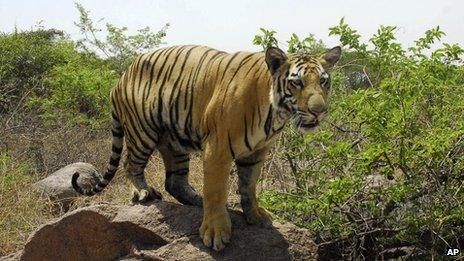Reasons why India's biodiversity is at risk
- Published

The number of tigers in India has risen in recent years, official figures show
Home to about a tenth of the world's known plant and animal species, India is a global biodiversity hot spot.
The country also has a bank of 50,000 varieties of rice, a grain that feeds about half of the world's population. Mangoes, tea, sorghum, millets and pulses grow freely on its lands.
But with 18% of the world's population crammed into just 2.4% of the global landmass, India's biodiversity is under pressure, something which the 12,000 delegates from 190 countries attending the UN meeting on biodiversity, external in the southern Indian city of Hyderabad will be aware about.
Here are some indicators of how India's biodiversity is under threat:
Four animals - the cheetah, Lesser Indian Rhinoceros, Pink-headed duck, external, and the Himalayan Mountain Quail, external - have become extinct in the last century.
A total of 929 animal species are threatened today, up from 648 in 2004, according to the International Union for Conservation of Nature, external (IUCN). India's rank in the global "shame list" of nations struggling to protect its species diversity has slid to seven, next to China.
Just 1% of India's 8,000km- (4,970-mile)-long coastline is protected from badly planned and illegal development. Coral reefs and fish are threatened by development projects like ports and power plants.
'Wide gap'
To be sure, India has explored and mapped the flora and fauna of only around 70% of its area, documenting some 150,000 plants and animals. Even the government admits there is a "wide gap" in mapping all species.
So the jury is still out on the total number of new and dying species. But in a country which spends about $2bn (£1.25bn) on biodiversity, there are some good tidings as well:

The Arunachal macaque was a surprise to science
Arunachal macaque, external a new species of monkey, was discovered in the north-eastern state of Arunachal Pradesh in 2005.
The Zoological Survey of India, external reported there were 193 species of animals in India in 2011.
The number of tigers has risen to 1,706 from 1,411 in 2006.
Some of the species are no longer endangered - this week, the IUCN, removed the Lion-tailed macaque from its list of 25 most endangered primates as its numbers have improved.
India's Environment Minister Jayanthi Natarajan says India "speaks from a position of strength as we need to balance economic development, poverty alleviation and protection of biodiversity".
But India needs to do a lot more. Forest cover is shrinking - authorities are talking about raising it to 33% from the existing 23%. India continues to struggle to protect the tiger, lion, elephant and rhino. And yes, it needs to complete the mapping of its biodiversity.
Pallava Bagla is correspondent for Science magazine; Science Editor of NDTV and author of Trees of India.
- Published13 October 2012